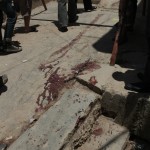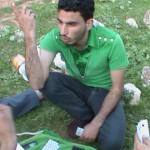14 July 2011 | International Solidarity Movement, Gaza
Following yesterday’s assault by the Israeli navy upon a trawler observing Israeli aggression in the three mile fishing radius along the Gaza coast, today warships again targeted two US observers and their Palestinian captain and threatened them that their next attempt at sailing would be fatal.
Alexandra Robinson, from Los Angeles, California, and Joe Catron of Queen Heights, Brooklyn, New York, are both participants in the Civil Peace Service of Gaza. They accompanied a Palestinian captain at approximately 7:30am this morning. “They often harass people within the three mile limit. We were actually setting out to follow a boat that was previous harassed,” said Robinson. International presence has helped deter abuse and harassment by Israeli navy. Upon sailing in a small trawler, 5 large Palestinian fishing boats were visible by Robinson, with 25 smaller ones also in plain sight. Within a half hour the crew saw warships approaching them with active water cannons about 20 meters away from the boat. According to Catron at 8:15 AM, the small boat was being circled by the warships with only about a distance of 10 meters between them. “The attack was pretty immediate,” said Catron. “They were very close and began to fire their water cannons at very high velocity.”
Robinson said they tried to withstand the power of the cannons, taking the brunt of the force with their turned backs. Catron also noticed about half a dozen visible navy personnel, some with guns aimed. “They also had one live ammunition cannon” that was revolving and aiming at the trawler, said Robinson. The warships were close enough to hear its crew when fire ceased at intervals, explained the internationals. “We shouted, ‘We are Americans, stop shooting,” but the crew was forced to abandon ship. A fishing boat had managed to come near the two observers and their captain, rescuing them. The fishing boat had several children on board, and the volunteers continued to plea with the navy. “We heard one of the officers on the warship respond, ‘Whether children or American, we will shoot,’ said Robinson.
While a member of the fishing boat rescued the trawler to take back to port, the captain of the trawler overheard one of the commanding officers speak orders to sink his trawler.
The warships followed the fishing boat for about an hour and a half, circling it so it was difficult for them to navigate to the coast. In a very clear threat made to the members of the trawler, a member of one of the warships was heard by all witnesses warning them to not sail as observers. The clear threat against both Palestinians and international observers was heard after an navy officer shouted over amplifier, “If you come back here, we will shoot you.” Passengers described the officers of the warship taunting them, questioning if they had caught any fish while emphasizing their threat.
Robinson and Catron, however, show no signs of absorbing the threat as influencing their future actions following the attack. “Friday is a day of rest here, but we will sail Saturday,” said Catron. “And this time we will take the media with us.” Yet Robinson does foresee an increase in Israeli incitement in the seas. “Our presence was effective in making Israeli’s leave the fishermen alone. But now that things have died down with the flotilla, they are starting to target us. We think it is only going to get worse from here.”
Today’s attack against the trawler comes following an attack yesterday against a British and Swedish observer who were accompanied by a Palestinian captain and a Palestinian civilian. No one was injured in either attack.
According to Palestine Human Rights Center, which condemned both attacks, of 20 nautical miles, Israeli navy often enforces between 1.5 – 2 nautical miles. The marine ‘buffer zone’ restricts Gazan fishermen from accessing 85% of Gaza’s fishing waters as agreed to in the Oslo Accords.




